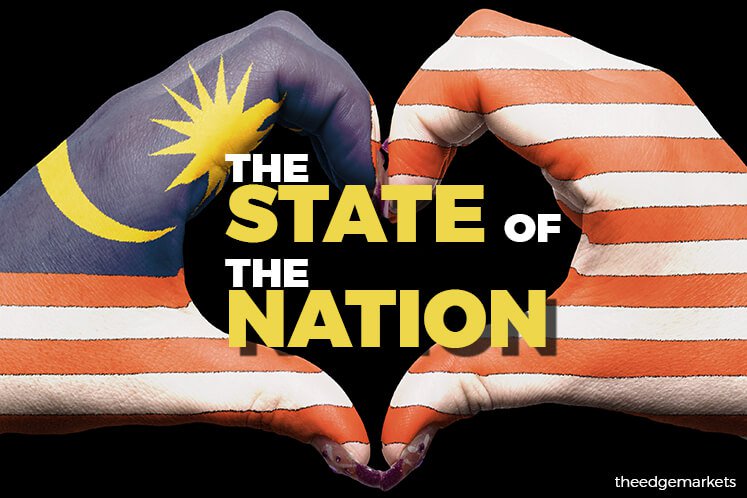THE country’s headline numbers are looking good. Bank Negara Malaysia’s foreign reserves are at their highest in two years and the upcoming second-quarter gross domestic product growth numbers are expected to add to the feel-good factor.
“Malaysia’s positive macro story is ringgit-supportive … this Friday’s release of 2Q GDP could surpass 1Q’s 5.6% year-on-year growth. Further infrastructure project rollouts are also important investment catalysts,” says UOB Malaysia economist Julia Goh, who recently raised her 2017 full-year GDP forecast to 5.2% from 5% on stronger exports and a higher trade surplus.
That is above the central bank’s projection of 4.3% to 4.8% growth for 2017, which Goh reckons could well be revised upward this Friday.
Goh is not alone. Economists at Maybank Investment Bank Research also expect the official GDP forecasts to be raised on Aug 18, with economic growth set “to remain above 5% in 2Q2017 and potentially 3Q2017”.
At least 12 economists see the economy growing at least 5% this year, Bloomberg data show at the time of writing. Capital Economics is the most bullish at 5.5% followed by JP Morgan’s 5.4% and Nomura Research’s 5.3%.
More forecasters have turned bullish on the ringgit. Mizuho Bank sees the ringgit strengthening above the RM4 mark to 3.95 to the greenback by June next year. Standard Chartered Bank, for another, sees the ringgit at 3.90 to the US dollar in 2018, compared with 4.10 to 4.20 for the rest of this year.
The positive momentum is a respite, which some experts see as a window for the country to replenish its coffers and reserves.
“While [Bank Negara’s] gross foreign reserves remain relatively ample, net foreign reserves have declined. Therefore, it would be prudent to maintain a flexible exchange rate [which does not require as much in reserves to manage shocks] and a tightening bias in the monetary policy stance to support the external position,” the Asean+3 Macroeconomic Research Office (AMRO) said in a recent statement.
Net reserves are derived from deducting short-term forward positions in foreign currencies — such as foreign exchange swaps and short positions — from the headline reserves. Bank Negara’s net reserves stood at US$82.37 billion as at end-June, after taking into account some US$16.56 billion in forex short positions. The latter was about 16.7% of (gross) reserves, down from its peak of 19.9% or US$19.1 billion in April this year.
It is worth noting that these short positions rose above 5% of the central bank’s overall reserve position in November 2016, the same month foreign banks were asked to give written commitments to stop trading ringgit non-deliverable forwards offshore.
That is not to say that the central bank’s US$99.4 billion reserves as at end-July are questionable as it is an internationally accepted way of reporting reserves.
“Net reserves would be lower. I wouldn’t say [net reserves] is [a] better [measure]. As long as you are able to roll the forward position over, it is not an issue. And at the moment, it doesn’t look like there is an issue at all because there are capital inflows, so it is not a concern,” says AMRO chief economist Dr Khor Hoe Ee.
UOB’s Goh concurs that the market is “watching both the overall level of foreign reserves and swap positions” and is positive on the swap positions falling from April to June, which suggests that the central bank had unwound some of its dollar borrowings.
For the record, foreign exchange swaps are one way central bankers manage liquidity and Bank Negara’s reserves remain ample at 7.9 months of retained imports and 1.1 times short-term external debt.
If Malaysia’s currency exchange rate were to be deemed as a “floating” regime, its reserves adequacy level would be 115% compared with 80% under a “fixed” regime, the International Monetary Fund said in an April 2017 report.
At US$99.4 billion, Bank Negara’s foreign reserves are still about 30% below their peak of US$141.43 billion in May 2013, before the Taper Tantrum, but have gained US$4.8 billion in the past seven months. Reserves are now only US$600 million shy of the US$100 billion psychological level they slipped under in June 2015.
Further gains could well be another sentiment boost for some. But AMRO’s Khor, for one, wouldn’t read too much into one figure that may be a boon and bane for central bankers.
“It’s psychological; there is no magic to it [US$100 billion psychological level]. But the problem with some of these psychological numbers is that they can constrain the central bank’s management. Sometimes there is a psychological level for the exchange rate and [a central bank] would try to defend it … that can be quite damaging.”
AMRO, which some parties refer to as an alternative to the IMF for Asia, currently expects Malaysia’s GDP to grow 4.9% in 2017 before moderating to 4.7% in 2018. The latter depends on how well the global economy performs amid signs of heightening geopolitical tensions.
“The impact of known risks like the US Federal Reserve rate hikes and expected balance sheet tapering in 2H2017, US-China trade tensions and emerging risks like the escalation of US-North Korea tensions are on our radar.
“Previous … bickering between the US and North Korea had a short-lived impact on markets. It remains to be seen whether North Korea’s threat to fire missiles at Guam will escalate further. For now, the National Liberation Day (celebrated by both North and South Korea) on Tuesday will be a closely watched date,” says Goh, who expects 2H2017 GDP growth to be slower than in 1H2017.
For now, though, the numbers look set to impress. If GDP expands 5% to 5.6% in 2Q2017, Malaysia only needs to grow an average of 4% to 4.3% in 3Q and 4Q to have 4.8% growth for the whole year. Consensus expectations are for GDP to come in at 5% for 2Q2017.


